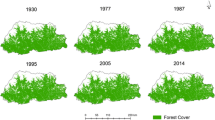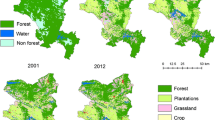Abstract
Sri Lanka is one of the biodiversity hotspots of the world. This study has utilized satellite remote sensing and GIS techniques to generate a nation-wide database on forests, forest types and land use/land cover of Sri Lanka. Spatial assessment of forest cover changes was carried out for the periods 1976–1985, 1985–1994, 1994–2005 and 2005–2014. The landscape fragmentation analysis has carried out to calculate the spatial and temporal patterns of forest. Land use/land cover map was prepared representing seven classes in 2014. The plantations occupy a large area (34.2%) followed by forests (33.4%) and agriculture (26.1%) in 2014. During the period of 1976–2014, the forest has been decreased by 5.5%. From 1976 to 1985 forest recorded a loss at an annual rate of 0.49%. This annual rate decreased to 0.01% during 2005–2014 indicates declining trend of deforestation and effective conservation measures. The study found deforestation hotspots in south east and northern most parts of the Sri Lanka. Total number of patches estimated has increased from 15193 in 1976 to 16136 in 2014. The study has found that main causes of deforestation in Sri Lanka were due to expansion of agriculture and plantations. The extent of change detected in the study through geospatial techniques has significance to the forest ecology and management of natural landscapes in Sri Lanka.







Similar content being viewed by others
References
Armenteras, D., Gast, F., & Villareal, H. (2003). Andean forest fragmentation and the representativeness of protected natural areas in the eastern Andes, Colombia. Biological Conservation, 113(2), 245–256.
Bandaratillake, H. M., & Sarath Fernando, M. P. (2003). National Forest Policy Review. Sri Lanka. An Overview of Forest Policies in Asia. FAO, Bangkok, 273–292. Available at: http://www.scribd.com/doc/27047662/national-forest-policy-review-sri-lanka.
Carter, J., Connelly, S., & Wilson, N. (1994). Participatory forestry in Sri Lanka: Why so limited? Change on the horizon. Network Paper-Rural Development Forestry Network (United Kingdom).
Champion, H. G., & Seth, S. K. (1968). A revised survey of the forest types of India. Delhi: Manager of Publications.
Chavez, P. S. (1996). Image-based atmospheric corrections-revisited and improved. Photogrammetric Engineering and Remote Sensing, 62(9), 1025–1035.
Chokkalingam, U., & Vanniarachchy, A. (2011). Sri Lanka’s REDD + Potential, Myth Or Reality?. Colombo: Forest Carbon Asia.
Congalton, R. G. (1991). A review of assessing the accuracy of classifications of remotely sensed data. Remote Sensing of Environment, 37(1), 35–46.
Foley, J. A., DeFries, R., Asner, G. P., Barford, C., Bonan, G., Carpenter, S. R., Chapin, F. S., Coe, M. T., Daily, G. C., Gibbs, H.K., Helkowski, J. H., Holloway, T., Howard, E. A., Kucharik, C. J., Monfreda, C., Patz, J. A., Prentice, I. C., Ramankutty, N., Snyder, P. K. (2005). Global consequences of land use. Science, 309(5734), 570–574.
Food and Agriculture Organisation of the United Nations (2009) State of the World’s Forests, Food and Agriculture Organization of the United Nations, Rome. Available at: http://www.fao.org/forestry/sofo/en/.
Food and Agriculture Organization of the United Nations. (2010). Global forest resources assessment 2010: Main report. Food and Agriculture Organization of the United Nations.
Fung, T. (1990). An assessment of TM imagery for land-cover change detection. IEEE Transactions on Geoscience and Remote Sensing, 28(4), 681–684.
Geist, H. J., & Lambin, E. F. (2002). Proximate Causes and Underlying Driving Forces of Tropical Deforestation Tropical forests are disappearing as the result of many pressures, both local and regional, acting in various combinations in different geographical locations. BioScience, 52(2), 143–150.
Getis, A., & Ord, J. K. (1996). Spatial analysis and modeling in a GIS environment. A Research Agenda for Geographic Information Science, 157–196.
Gunatilleke, I. A. U. N., Gunatilleke, C. V. S., & Dilhan, M. A. A. B. (2005). Plant biogeography and conservation of the southwestern hill forests of Sri Lanka. The Raffles Bulletin of Zoology, Supplement, 12, 9–22.
Hansen, M. C., Stehman, S. V., & Potapov, P. V. (2010). Quantification of global gross forest cover loss. Proceedings of the National Academy of Sciences, 107(19), 8650–8655.
http://earth.google.com/. Accessed 15 Aug 2015.
http://glcfapp.umiacs.umd.edu:8080/esdi. Accessed 17 July 2015.
http://www.globallandcover.com/GLC30Download/index.aspx) Accessed 21 July 2015.
http://www.ipcc.ch/. Accessed 7 July 2015.
http://www.lib.utexas.edu/maps/ams/india/last. Accessed 11 Nov 2014.
http://www.meteo.gov.lk/index.php. Accessed 6 July 2015.
Hansen, M. C., Potapov, P. V., Moore, R., Hancher, M., Turubanova, S. A., Tyukavina, A., Thau, D., Stehman, S. V., Goetz, S. J., Loveland, T.R., Kommareddy, A., Egorov, A., Chini, L. Justice, C. O., Townshend, J. R. G. (2013). High-resolution global maps of 21st-century forest cover change. Science, 342(6160), 850–853.
Illangasinghe, W., Fujiwara, K., & Saito, H. (1999). A Preliminary Study of Forests in Sri Lanka. Bulletin Institute of Environmental Science and Technology Yokohama National University, 25(1), 9–38.
IPCC, Climate Change, Synthesis Report. (2007). Contribution of Working Groups I, II and III to the Fourth Assessment Report of the Intergovernmental Panel on Climate Change [Core Writing Team, Pachauri, R.K and Reisinger, A. (eds.)]. IPCC, Geneva, Switzerland, 104 pp.
Karunathilake, K. M. B. C. (2010). Status of mangroves in Sri Lanka. Journal of Coastal Development, 7(1), 5–9.
Koch, B. (2010). Status and future of laser scanning, synthetic aperture radar and hyperspectral remote sensing data for forest biomass assessment. ISPRS Journal of Photogrammetry and Remote Sensing, 65(6), 581–590.
Lindström, S. (2011). Tropical deforestation in Sri Lanka. Sri Lanka: University of Gothenburg.
Macleod, R. D., & Congalton, R. G. (1998). A quantitative comparison of change-detection algorithms for monitoring eelgrass from remotely sensed data. Photogrammetric Engineering and Remote Sensing, 64(3), 207–216.
McGarigal, K., & Cushman, S. A. (2002). Comparative evaluation of experimental approaches to the study of habitat fragmentation effects. Ecological Applications, 12(2), 335–345.
Midha, N., & Mathur, P. K. (2010). Assessment of Forest Fragmentation in the Conservation Priority Dudhwa Landscape. India using FRAGSTATS Computed Class Level Metrics, Journal of Indian Society of Remote Sensing, Special issue on Biodiversity and Landscape Ecology, 38, 487–500.
Nanayakkara, V.R. (1996). Forests and forestry in Sri Lanka: an historical perspective. Commonwealth Secretariat.
Nelson, A., & Chomitz, K. M. (2011). Effectiveness of strict vs. multiple use protected areas in reducing tropical forest fires: A global analysis using matching methods. PLoS ONE, 6(8), e22722.
Perera, G. A. D. (2001). The secondary forest situation in Sri Lanka: A review. Journal of Tropical Forest Science, 13(4), 768–785.
Puyravaud, J. P. (2003). Standardizing the calculation of the annual rate of deforestation. Forest Ecology and Management, 177(1), 593–596.
Reddy, C. S., Jha, C. S., & Dadhwal, V. K. (2013). Assessment and monitoring of long-term forest cover changes in Odisha, India using remote sensing and GIS. Environmental Monitoring and Assessment, 185(5), 4399–4415.
Reddy, C. S., Jha, C. S., Diwakar, P. G., & Dadhwal, V. K. (2015a). Nationwide classification of forest types of India using remote sensing and GIS. Environmental Monitoring and Assessment,. doi:10.1007/s10661-015-4990-8.
Reddy, C. S., Rajashekar, G., Hari Krishna, P., Jha, C. S., & Dadhwal, V. K. (2015b). Multi-source and multi-date mapping of deforestation in Central India (1935–2010) and its implication on standing phytomass carbon pool. Ecological Indicators, 57, 219–227.
Reddy, C. S., Jha, C. S., Dadhwal, V. K., Hari Krishna, P., Pasha, S. V., Satish, K. V., Dutta, K., Saranya, K.R.L., Rakesh, F., Rajashekar, G., Diwakar, P.G. (2016a). Quantification and monitoring of deforestation in India over eight decades (1930–2013). Biodiversity and Conservation, 25, 93–116.
Reddy, C. S., Pasha, S. V., Jha, C. S., Diwakar, P. G., & Dadhwal, V. K. (2016b). Development of national database on long-term deforestation (1930–2014) in Bangladesh. Global and Planetary Change,. doi:10.1016/j.gloplacha.2016.02.003.
Rodrigues, A. S., Akcakaya, H. R., Andelman, S. J., Bakarr, M. I., Boitani, L., Brooks, T. M., Chanson, J. S., Fishpool, L.D. C., Da Fonseca, G. A. B., Gaston, K.J., Hoffmann, M., Marquet, P. A., Pilgrim, J. D., Pressey, R. L., Schipper, J., Sechrest, W., Stuart, S. N., Underhill, L. G., Waller, R. W., Watts, M. E. J., Yan, X. (2004). Global gap analysis: Priority regions for expanding the global protected-area network. BioScience, 54(12), 1092–1100.
Skole, D., & Tucker, C. (1993). Tropical deforestation and habitat fragmentation in the Amazon using satellite data from 1978 to 1988. Science, 260(5116), 1905–1910.
United Nations (2009) World population prospects: The 2008 revision population database. http://esa.un.org/wup2009/unup/index.asp. Accessed 10 Mar 2015.
Wulder, M. A., White, J. C., Cranny, M., Hall, R. J., Luther, J. E., Beaudoin, A., Goodenough, D. G., Dechka, J. A (2008). Monitoring Canada’s forests. Part 1: Completion of the EOSD land cover project. Canadian Journal of Remote Sensing, 34(6), 549–562.
Acknowledgements
The present work has been carried out as part of ISRO’s National Carbon Project. We gratefully acknowledge ISRO-DOS Geosphere Biosphere Programme for supporting this research. Thanks to anonymous reviewers for critical comments helped to improve the manuscript.
Author information
Authors and Affiliations
Corresponding author
About this article
Cite this article
Sudhakar Reddy, C., Manaswini, G., Jha, C.S. et al. Development of National Database on Long-term Deforestation in Sri Lanka. J Indian Soc Remote Sens 45, 825–836 (2017). https://doi.org/10.1007/s12524-016-0636-8
Received:
Accepted:
Published:
Issue Date:
DOI: https://doi.org/10.1007/s12524-016-0636-8




